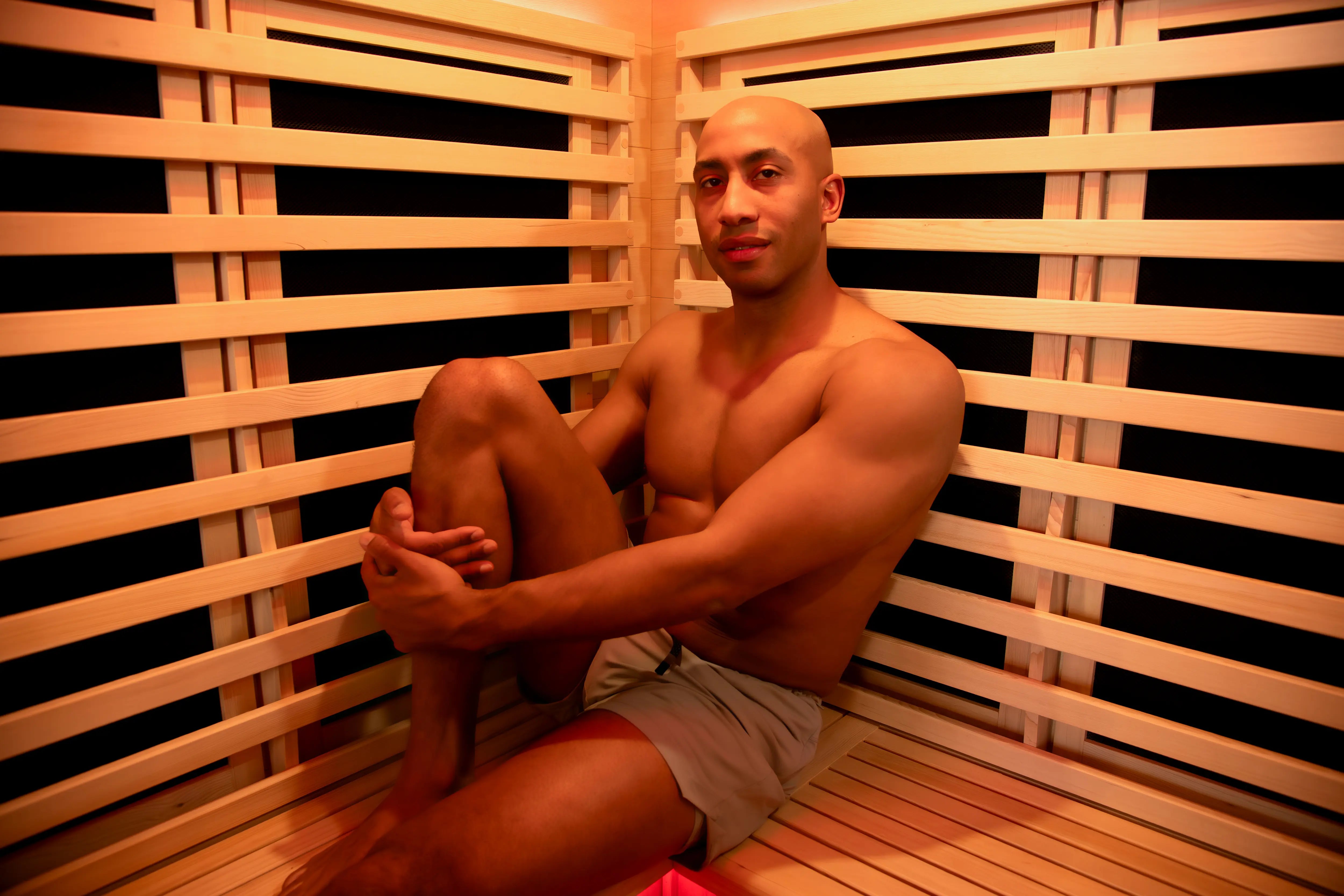The sauna has come a long way since people first began digging pits into the ground or hillside, adding hot stones to the pit and then creating a makeshift enclosure with animal hides. There are now traditional Finnish saunas, barrel saunas designed for outdoor use, portable saunas, and infrared saunas.
Each type of sauna is designed to help you break a sweat — and get the benefits that a really good sweat offers. Adding in sauna sessions to your wellness routine can help you relax, detox, and support your overall health and well-being.
Both promise to provide a rejuvenating experience that focuses on your well-being, but there are some key differences between the two that are worth exploring. And the differences between an infrared sauna and traditional sauna can go beyond the heat source.
Whether you're a sauna connoisseur or a newcomer looking to enhance your wellness routine, understanding these differences will help you choose the best at-home sauna.

Comparing traditional and infrared sauna
A wood-lined structure or room, a stove or heater with a stack of stones, a bucket of water with a ladle. When you think of a sauna, many people picture the traditional sauna that has its roots in Finland and other nordic countries.
And for many sauna enthusiasts, the Finnish-style sauna is the only true sauna.
But in the 1970s, the first infrared saunas were introduced to the market. An alternative to the traditional sauna, these saunas take inspiration from the sun and emit infrared heat for a more targeted experience.
Heat source
Traditional saunas typically use a wood stove or electric heater to heat the air inside the sauna. The result is a dry, intense heat that — with the air temperature sometimes reaching 230 degrees Fahrenheit.
On the other hand, infrared saunas use infrared heating elements to heat the objects and people in the sauna directly, rather than heating the air. The temperatures in an infrared sauna are lower, usually ranging between 120 degrees to 160 degrees, resulting in a more gentle and penetrating heat.

Heat penetration
The difference in heat source also affects how deeply the heat penetrates the body, ultimately impacting the detoxification process. In traditional saunas, the heat primarily affects the surface of the skin, causing sweating and opening up the pores. This process can help eliminate toxins from the body through sweat
Infrared saunas, on the other hand, utilize infrared light waves to penetrate deeper into the body, reaching up to 1.5 inches below the skin's surface. This deeper penetration promotes a more intense detoxification process, as it can stimulate the release of toxins stored in fat cells and other tissues.
Space and cost
Another factor to consider when choosing between the two is the space and cost. Traditional saunas tend to require more space due to the heating element and ventilation requirements. They can also be more expensive to install and maintain, especially if you opt for a wood-fired sauna.
Traditional saunas are often installed outdoors as they will add to the overall humidity of a home — especially if you are ladling water on top of stones. This humidity can cause damage and even lead to microbial growth.
Most are designed to be used indoors and some can even be used in a small apartment or home.
But how much does a sauna cost?
The price tag on a traditional sauna can vary widely based on the size, materials, and customization options. A barrel sauna might cost less than a Finnish sauna cabin, with prices ranging from $7,000 to $50,000.
Infrared saunas also range in price depending on the quality, materials, and features. Sweaty GOAT Saunas range in price $6,995 to $8,495.
When you are comparing traditional saunas and infrared saunas, the latter option might be the more practical one. Infrared saunas require less of an investment — in terms of money and time.

Set-up
Infrared saunas can be designed to be easy to assemble and install. For example, Sweaty GOAT Saunas feature modular panels that connect together quickly while locking securely into place. The electrical, too, is already hardwired and requires only a 110V/20-amp outlet.
But if you are thinking about a traditional sauna, you need to grab your tool box with a tape measure, your square, and mallet.
Traditional saunas often have a more involved set-up process, requiring a range of tools and several hours. In addition, most heaters require a hardwired 240V connection. What does that mean? You’ll need to call in a licensed electrician to finish the set-up process of your sauna.

Health benefits of infrared sauna vs traditional
You’re going to sweat when you get in a sauna, whether it’s 10 minutes in an infrared model or 20 minutes in a traditional version.
Brief exposure to intense heat provides a beneficial form of stress for your body. This stress triggers heightened cellular repair, enhanced cardiovascular function, and improved stress tolerance, among other health benefits.
Traditional saunas provide health benefits by heating the air around you, which then causes you to warm up and sweat. Infrared saunas, though, emit wavelengths to penetrate the skin and heat the body from within.
Cardiovascular health
The cardiovascular benefits include improved blood circulation, lower blood pressure, and increased heart rate, which mimics the effects of moderate physical exercise.
Your stress response can be higher in a traditional Finnish sauna, which can amplify the cardiovascular benefits. Long-term studies show that using a traditional sauna on a regular basis — three to seven times a week — is associated with reduced risk of sudden cardiac death, fatal coronary heart disease, and fatal cardiovascular disease.
However, not everyone can tolerate the higher temperatures of a dry sauna.
Energy levels
Infrared saunas are known for their ability to penetrate your tissue, up to 2 inches. This high heat penetration has the potential to positively impact your health on a cellular level. One study found that people who used a sauna for six days in a row saw a 28% increase in mitochondrial function.
Mitochondria are the energy powerhouses within your cells. When you can improve the mitochondria’s ability to work, you will notice an increase in your energy. But more than that, optimizing mitochondria function is important to your longevity and sustained vitality, allowing your body to work its best.
The study focused on the benefits of far-infrared heat and its ability to support mitochondria. Sweaty GOAT Saunas feature a 360-heating system that uses a spectrum of infrared waves for maximum benefit.
Additional health benefits
The lower temperatures and deeper penetration of infrared saunas, which can be more appealing if you are seeking relief from chronic pain, muscle injuries, arthritis, and even skin conditions such as psoriasis and eczema.
Infrared saunas are also known for promoting relaxation, reducing stress, and improving overall well-being.

Which type of sauna is best?
Traditional saunas have been used for millennia to promote relaxation and improve health. However, with the introduction and advancement of far-infrared saunas, there is an alternative to the standard sweat session.
There are people who stand firm that conventional saunas are better than infrared. However there are distinct advantages to options like the Sweaty GOAT that make it a stand-out option.
Head-to-toe heating
The Sweaty GOAT provides a 360-heating experience, evenly warming the body. The range of infrared rays are able to go beyond the skin and into the muscle and tissue — over an inch and a half.
The direct penetration into muscles not only promotes relaxation but also provides myriad benefits, including improved circulation, detoxification, and even muscle recovery.
The unique combination of heating panels allows you to benefit from sauna therapy at a more comfortable temperature, typically between 120 degrees and 140 degrees. Owners can control the temperature, too, with the easy-to-use panel. Set a timer for the sauna to turn on and choose a temperature based on your preferred sauna protocol.
Too hot?
Conventional saunas rely on steam and indirect means of heat. First, the air is warmed, which then indirectly contacts the skin to produce therapeutic effects. The consequence? Sauna-goers often find themselves in rooms with temperatures exceeding 200 degrees.
And it can take longer to get the sauna to temperature compared to an infrared sauna. For example, it can take 35 minutes for a Finnish sauna to reach your desired temperature. The Sweaty GOAT needs about half the time.
Maintenance
Investing in a sauna promises to help you live life better. But, like many additions to your home, it will require routine care to ensure its longevity.
Infrared saunas are low-maintenance, because there is not a lot of steam or humidity. Owners don’t have to worry about curbing the potential growth of mildew and mold.
In contrast, conventional saunas are known for their hot and humid environment, which can become breeding grounds for mildew.
It’s important, though, to choose a sauna that offers a therapeutic and relaxing experience. The best type of sauna will be the one that fits your needs, space, and budget.
Choosing the best infrared sauna
Do you want to enjoy the benefits of sauna therapy without having to book an appointment at a spa or share space at a gym? Having a Michael Phelps Sweaty GOAT Sauna allows you to realize the benefits of sauna therapy. You can click here to find out more about the benefits of incorporating a Michael Phelps Sweaty GOAT sauna into your routine. Rejuvenate your wellness routine today!






Pro triathlete Ben Kanute’s ‘cool’ recovery secret
Can using a sauna aid weight loss? Understanding the science